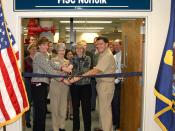With the world growing smaller by the day, or as Thomas Friedman says "getting flatter", many U. S. companies are trying to regain their competitive advantage. Many companies are finding that it is quite difficult to acquire new business. However, some companies have recently discovered a new way to cut costs. This "new" way to cut costs is to work closely with suppliers, otherwise known in the business world as supplier development.
Northrop Grumman Corporation (a.k.a. Northrop) is one of the largest defense contractors in the world headquartered in Los Angeles, California. The organization operates in seven different business sectors:
* Electronic systems (radar, navigation, and communication systems)
* Information technology (computer systems, training and simulation software)
* Integrated systems (military aircraft)
* Ship systems (non-nuclear military and commercial ships)
* Newport News (nuclear military surface ships and submarines)
* Mission systems (command and control systems, missile systems)
* Space technology (military and civil space technology)
This text will focus on the integrated systems business sector of Northrop.
Supplier development is important for a few reasons. First, and probably most importantly, material cost is over half of total product cost ($0.55 of every $1 in revenue is spent on material). Since Northrop's customer base is relatively fixed, it is quite difficult for the company to obtain new business. The company's efforts are more focused on decreasing material cost. Secondly, supplier development can have a profound effect on gross profit. The relationship between in increase in sales versus a decrease in material cost is 5:1. This means that a $5 increase in sales has the same effect on profit as a $1 decrease in material and supply chain costs. Next, international competition is forcing companies to produce more products with less people. This means that companies are purchasing more and adding...


